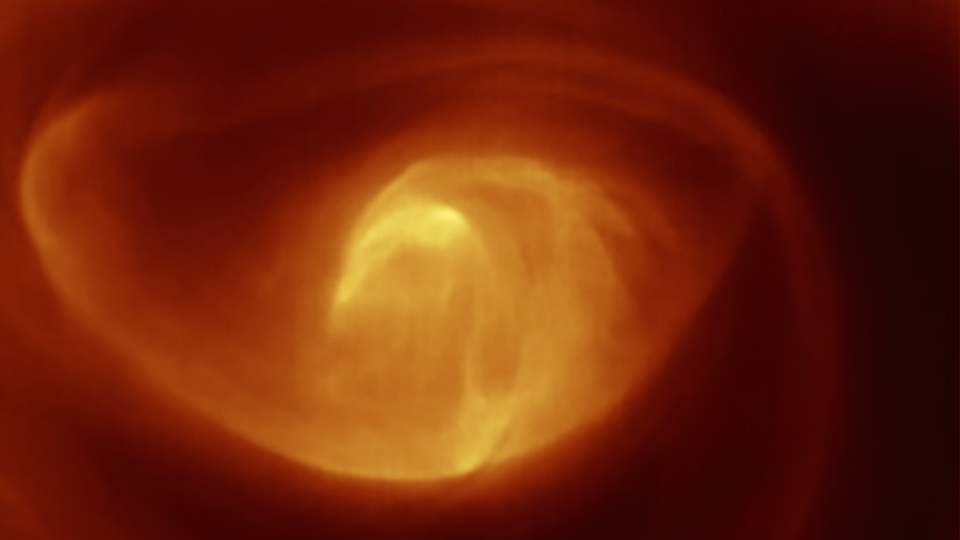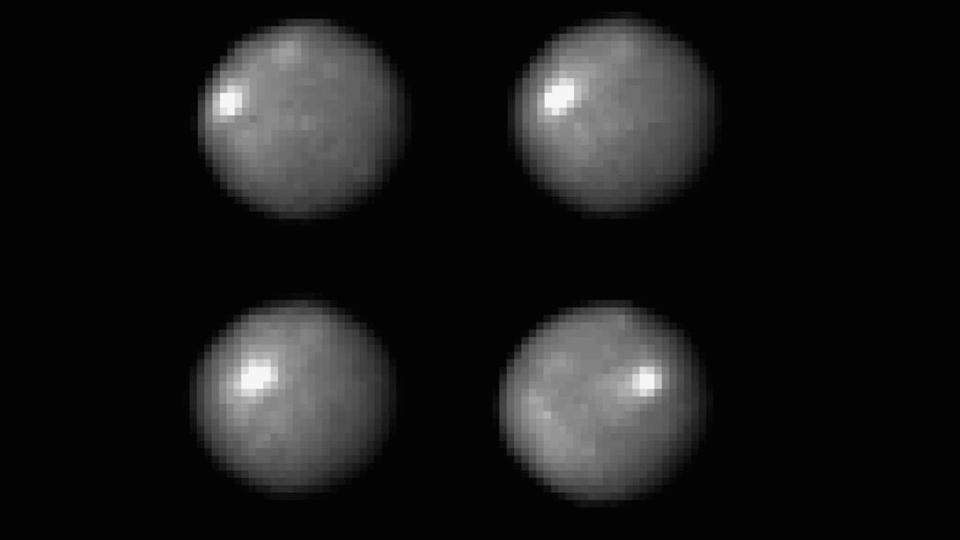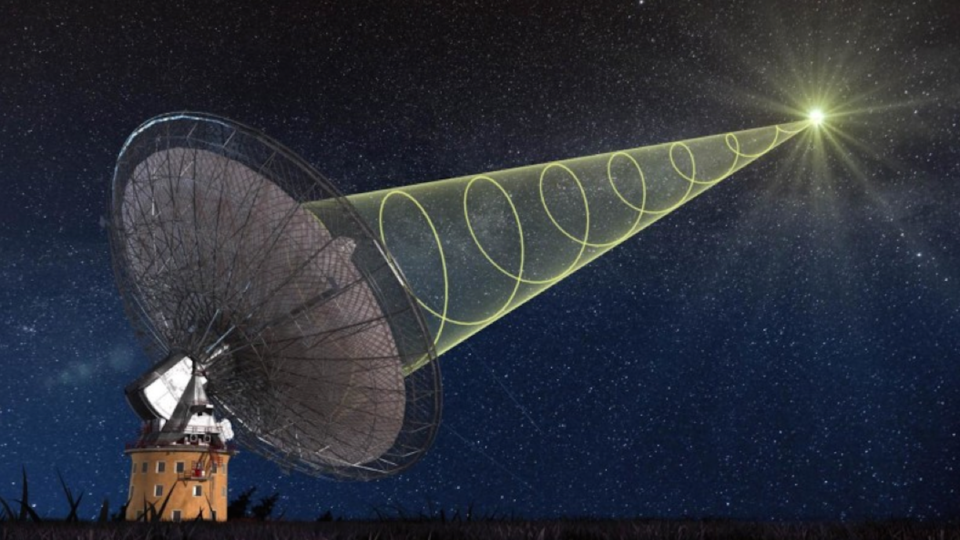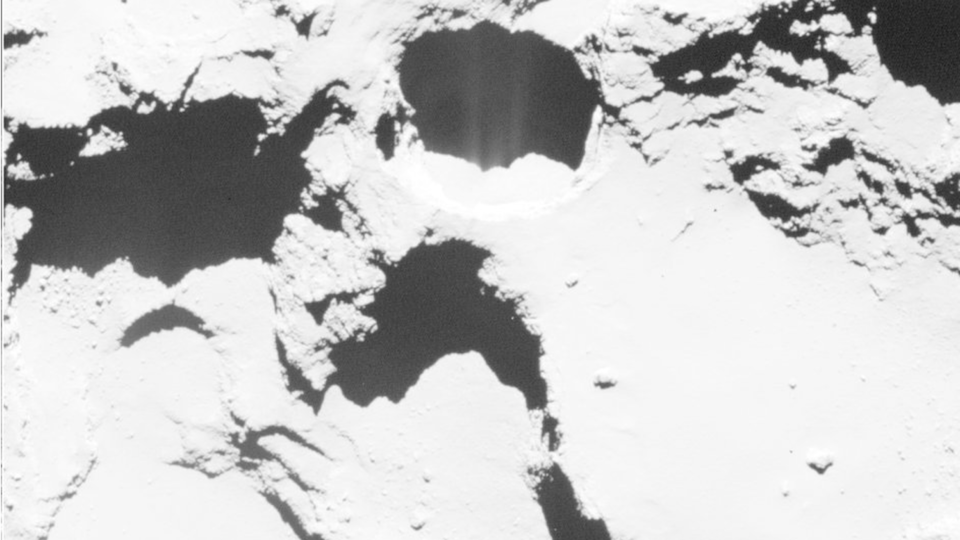Science News
A Vortex, a Spot, a Burst, and a Phollow-Up
Venus Vortex
This week, the European Space Agency (ESA) released images of the vortex at the south pole of Venus, taken by the Visible and Infrared Thermal Imaging Spectrometer (VIRTIS) aboard the Venus Express spacecraft. The photos themselves are hardly new—they were actually taken in April 2007, only a year after the craft took the very first detailed images of the same polar storm.
Where did this long-lasting polar storm come from? Venus has a choppy and fast-moving atmosphere, with winds up to 400 kilometers per hour at the cloud tops. At this altitude, some 70 kilometers above the surface, Venus’s atmosphere spins at a dizzying speed 60 times faster than the planet itself. For comparison, Earth’s fastest winds move at most about 30% of our planet’s rotation speed. Venus’s fast winds rise and carry air warmed in the equatorial latitudes, and then they spiral toward the poles. As the air converges on the pole, it then sinks, creating a vortex.
Over the course of its mission, Venus Express has recorded the vortex constantly transforming and reshaping, from a double vortex into its current eye-like structure.
The Venus vortex is hardly the only interesting storm in the Solar System, the most well-known being Jupiter’s Great Red Spot. First noted in 1665, it has been raging in the upper atmosphere of the largest planet for at least 350 years, defying current theories of how vortices could last so long. But on a planet the size of Earth (compared to the behemoth Jupiter, a thousand times as massive as our home world), Venus’s persistent polar storm is a fascinating phenomenon. -Elise Ricard
Ceres Has a Spot and Gas
As NASA’s Dawn mission draws ever closer to the dwarf planet Ceres, scientists are increasingly excited to solve a few mysteries about the largest object in the asteroid belt.
We currently know very little about conditions on this small, rocky object, but speculation abounds. Since the composition of the outer layers is somewhere between water and silicon-based rock, many scientists think that some portion of the outermost region is dust-covered ice (both dust and ice being common ingredients in asteroid belt objects).
However, scientist Tom McCord thinks that subsurface heating caused by radioactive decay occurs at high enough levels to melt that ice into a liquid—and potentially into a gas. We have seen abundant outgassing (water heated enough to escape the surface and vent out into space) on Ceres, but some of the energy at the surface must be coming from the Sun’s rays, not solely from within.
Other surface features are just as perplexing. A decade ago, the Hubble Space Telescope team observed Ceres. Scientists confirmed that Ceres was indeed a round object, as suspected, with a fairly uniform surface—except for one bright spot! This feature has remained a mystery ever since.
Until Dawn arrives early this March, we are left to speculate, but it is exciting to imagine what we will find on Ceres. -Josh Roberts
Live Fast Radio Burst
This week, a team of astronomers reported the real-time detection of a fast radio burst, or FRB. It’s a relatively new term that describes an extremely short, sharp flash of radio waves from an unknown source in the Universe. Since the first discovery of FRBs in 2007, several more have been detected, but only long after the fact, uncovered by scientists in archival data from radio telescopes in Australia and Puerto Rico.
But this time, researchers were looking for a live one! Emily Petroff of Swinburne University of Technology, was using the Parkes Radio Telescope in Eastern Australia on May 14 last year when she spotted the FRB. Recording the burst location, she alerted a number of other telescopes around the world—on ground and in space—in order to make follow-up observations at other wavelengths.
The other telescopes detected nothing. But the team didn’t come up empty-handed, says astrophysicist Daniele Malesani of the University of Copenhagen. “We found out what it wasn’t. The burst could have hurled out as much energy in a few milliseconds as the Sun does in an entire day. But the fact that we did not see light in other wavelengths eliminates a number of astronomical phenomena that are associated with violent events such as gamma-ray bursts from exploding stars and supernovae, which were otherwise candidates for the burst.”
Could it be intelligent life trying to make contact? If so, they are very far away. The burst came from well outside the Milky Way galaxy at 5.5 billion light years away. Malesani has more down-to—er, more realistic possibilities. “The theories are now that the radio wave burst might be linked to a very compact type of object—such as neutron stars or black holes—and the bursts could be connected to collisions or star quakes. Now we know more about what we should be looking for,” he says. -Molly Michelson
Philae Still Not Phound (Rosetta Comet Mission Update)
Although ESA officials still have not determined exactly where the Philae lander rests on the surface of Comet 67P/Churyumov-Gerasimenko, mission controllers are confident that it’s still there… somewhere.
The washing-machine-sized spacecraft, which came to a bouncy landing on the comet’s surface on November 12, is thought to rest on its back, unanchored to the ground, on the far end of the smaller of the two lobes that form the comet’s “rubber-duck” shaped nucleus (somewhere on the duck’s “head”). However, it also isn’t expected to be in any imminent danger of being blasted off into space by one of the comet’s erupting jets of gas, many of which have been photographed by the orbiting, still-functioning Rosetta spacecraft. In the weak gravity of the comet, Philae is estimated to weigh about a gram, about as much as a standard business card or a paperclip, and a good blast of gas would be enough to toss it back into space. However, much of the outgassing appears to be occurring along the thin “neck” of the comet, on the narrow connection between the two lobes.
Rosetta’s high-resolution cameras have already captured many detailed images of the comet’s surface, some of which have been released, but most are under a six-month embargo to allow principle scientists to study them first. Whether any of those images can help pinpoint Philae’s location isn’t known at this time. Mission managers continue to hope that as the comet approaches the Sun (toward perihelion in August 2015), the lighting angle will change enough to shine on Philae’s solar panels, bringing the lander back to life so it can communicate with Rosetta. Only then can they be certain that the little lander still sits on the head of the biggest “rubber duck” in the solar system. -Bing Quock
Images: Vortex, ESA/VIRTIS/INAF-IASF/Obs. de Paris-LESIA/Univ. Oxford; Ceres Spot, NASA, ESA, J. Parker (Southwest Research Institute), P. Thomas (Cornell University), and L. McFadden (University of Maryland, College Park); Radio telescope, Swinburne Astronomy Productions; Comet 67P, ESA/Rosetta/MPS for OSIRIS Team MPS/UPD/LAM/IAA/SSO/INTA/UPM/DASP/IDA



